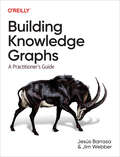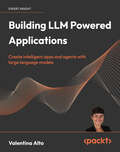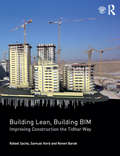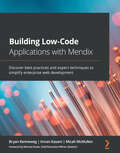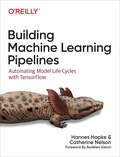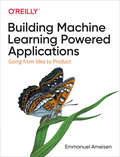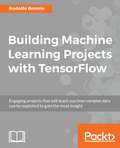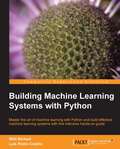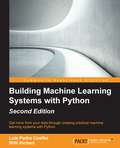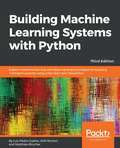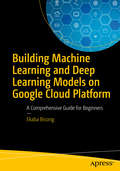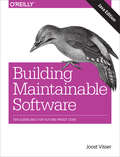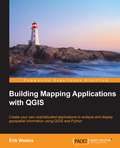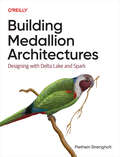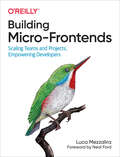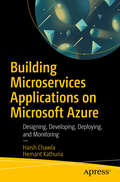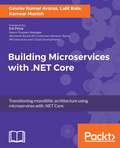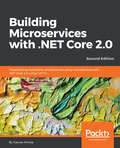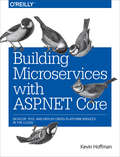- Table View
- List View
Building JavaTM Enterprise Applications Volume I: Architecture
by Brett MclaughlinVolume 1 of this advanced 3-volume guide explores the infrastructure issues so important to good application design. It isn?t just a book about Entity Beans and JNDI. It takes you step by step through building the back end, designing the data store so that it gives you convenient access to the data your application needs; designing a directory; figuring out how to handle security and where to store security credentials you need; and so on.
Building Knowledge Graphs: A Practitioner's Guide
by Jim Webber Jesus BarrasaIncredibly useful, knowledge graphs help organizations keep track of medical research, cybersecurity threat intelligence, GDPR compliance, web user engagement, and much more. They do so by storing interlinked descriptions of entities—objects, events, situations, or abstract concepts—and encoding the underlying information. How do you create a knowledge graph? And how do you move it from theory into production?Using hands-on examples, this practical book shows data scientists and data engineers how to build their own knowledge graphs. Authors Jesús Barrasa and Jim Webber from Neo4j illustrate common patterns for building knowledge graphs that solve many of today’s pressing knowledge management problems. You’ll quickly discover how these graphs become increasingly useful as you add data and augment them with algorithms and machine learning.Learn the organizing principles necessary to build a knowledge graphExplore how graph databases serve as a foundation for knowledge graphsUnderstand how to import structured and unstructured data into your graphFollow examples to build integration-and-search knowledge graphsLearn what pattern detection knowledge graphs help you accomplishExplore dependency knowledge graphs through examplesUse examples of natural language knowledge graphs and chatbotsUse graph algorithms and ML to gain insight into connected data
Building LLM Powered Applications: Create intelligent apps and agents with large language models
by Valentina AltoGet hands-on with GPT 3.5, GPT 4, LangChain, Llama 2, Falcon LLM and more, to build LLM-powered sophisticated AI applicationsKey FeaturesEmbed LLMs into real-world applicationsUse LangChain to orchestrate LLMs and their components within applicationsGrasp basic and advanced techniques of prompt engineeringBook DescriptionBuilding LLM Powered Applications delves into the fundamental concepts, cutting-edge technologies, and practical applications that LLMs offer, ultimately paving the way for the emergence of large foundation models (LFMs) that extend the boundaries of AI capabilities. The book begins with an in-depth introduction to LLMs. We then explore various mainstream architectural frameworks, including both proprietary models (GPT 3.5/4) and open-source models (Falcon LLM), and analyze their unique strengths and differences. Moving ahead, with a focus on the Python-based, lightweight framework called LangChain, we guide you through the process of creating intelligent agents capable of retrieving information from unstructured data and engaging with structured data using LLMs and powerful toolkits. Furthermore, the book ventures into the realm of LFMs, which transcend language modeling to encompass various AI tasks and modalities, such as vision and audio. Whether you are a seasoned AI expert or a newcomer to the field, this book is your roadmap to unlock the full potential of LLMs and forge a new era of intelligent machines.What you will learnExplore the core components of LLM architecture, including encoder-decoder blocks and embeddingsUnderstand the unique features of LLMs like GPT-3.5/4, Llama 2, and Falcon LLMUse AI orchestrators like LangChain, with Streamlit for the frontendGet familiar with LLM components such as memory, prompts, and toolsLearn how to use non-parametric knowledge and vector databasesUnderstand the implications of LFMs for AI research and industry applicationsCustomize your LLMs with fine tuningLearn about the ethical implications of LLM-powered applicationsWho this book is for Software engineers and data scientists who want hands-on guidance for applying LLMs to build applications. The book will also appeal to technical leaders, students, and researchers interested in applied LLM topics. We don’t assume previous experience with LLM specifically. But readers should have core ML/software engineering fundamentals to understand and apply the content.
Building Lean, Building BIM: Improving Construction the Tidhar Way
by Rafael Sacks Samuel Korb Ronen BarakBuilding Lean, Building BIM is the essential guide for any construction company that wants to implement Lean Construction and Building Information Modelling (BIM) to gain a strategic edge over their competition. The first of its kind, the book outlines the principles of Lean, the functionality of BIM, and the interactions between the two, illustrating them through the story of how Tidhar Construction has implemented Lean Construction and BIM in a concerted effort over four years. Tidhar is a small-to-medium-sized construction company that pioneered a way of working that gave it a profit margin unheard of in its market. The company's story serves as a case study for explanation of the various facets of Lean Construction and BIM. Each chapter defines a principle of Lean and/or BIM, describes the achievements and failures in Tidhar's implementation based on the experiences of the key people involved, and reviews the relevant background and theory. The implementation at Tidhar has not been a pure success, but by examining their motives alongside their achievements and failures, readers will learn about what pitfalls and pinnacles to expect. A number of chapters also compare the experience of Tidhar with those of other companies who are leaders in their fields, such as Skanska and DPR. This book is highly relevant and useful to a wide range of readers from the construction industry, especially those who are frustrated with the inefficiencies in their companies and construction projects. It is also essential reading for Lean and BIM enthusiasts, researchers and students from a variety of industries and backgrounds.
Building Learning Experiences in a Changing World (Advances in Business Education and Training #3)
by Wim H. Gijselaers Piet Van den Bossche Richard G. MilterAdvances in Business Education & Training is a Book Series to foster advancement in the field of Business Education and Training. It serves as an international forum for scholarly and state-of-the-art research and development into all aspects of Business Education and Training. This new volume deals with several aspects of the challenge to design learning in and for a changing world. The first part concerns program development. How to build curricula that are future-proof? Principles to innovate our curricula are identified. It answers the question how we can incorporate the need for change in our thinking about curriculum-development and identify the necessary elements to incorporate in our curricula. The second part focuses on the increasing diversity of students and employees within our schools and organizations, in terms of culture, language, and perception of ability, gifts, and talents. This offers a range of opportunities, but at the same time can possibly jeopardize some processes that are taken for granted. Chapters in this part analyze the processes that play a crucial role in dealing with this diversity and identify educational practices that can help to harvest the potential that lies within this diversity. The third part of this book digs further into the possibilities that are opened up by the implementation of ICT-support in our learning environments. E-learning provides tools to adapt these environments to the needs of an increasingly diverse student-population. In the last part we focus specifically on the workplace and how learning can be designed in such a way that employees are equipped for a shifting workplace. On the one hand it is looked how training can affect performance in the workplace. Does learning transfer to the work environment? On the other hand it is questioned how one can design affordances to trigger learning in the workplace.
Building Levels in Unity
by Volodymyr GerasimovThe book is aimed at game artists with no past programming experience who are interested in designing levels in Unity. It does not assume detailed knowledge of similar game platforms.
Building Low-Code Applications with Mendix: Discover best practices and expert techniques to simplify enterprise web development
by Bryan Kenneweg Imran Kasam Micah McMullen Michael GuidoTransform your app ideas into fully functional prototypes with the help of expert tips and best practices from Mendix partnersKey FeaturesMeet the ever-increasing demand for software solution delivery without having to write any codeBuild high-availability, low-cost applications unlike those developed via a traditional software engineering approachExplore Mendix from product design through to delivery using real-world scenariosBook DescriptionLow-code is a visual approach to application development. It enables developers of varying experience levels to create web and mobile apps using drag-and-drop components and model-driven logic through a graphic user interface. Mendix is among the fastest-growing platforms that enable low-code enthusiasts to put their software ideas into practice without having to write much code, and Building Low-Code Applications with Mendix will help you get up and running with the process using examples and practice projects. The book starts with an introduction to Mendix, along with the reasons for using this platform and its tools for creating your first app. As you progress, you'll explore Mendix Studio Pro, the visual environment that will help you learn Mendix app creation. Once you have your working app ready, you'll understand how to enhance it with custom business logic and rules. Next, you'll find out how to defend your app against bad data, troubleshoot and debug it, and finally, connect it with real-world business platforms. You'll build practical skills as the book is filled with examples, real-world scenarios, and explanations of the tools needed to help you build low-code apps successfully. By the end of this book, you'll have understood the concept of low-code development, learned how to use Mendix effectively, and developed a working app.What you will learnGain a clear understanding of what low-code development is and the factors driving its adoptionBecome familiar with the various features of Mendix for rapid application developmentDiscover concrete use cases of Studio ProBuild a fully functioning web application that meets your business requirementsGet to grips with Mendix fundamentals to prepare for the Mendix certification examUnderstand the key concepts of app development such as data management, APIs, troubleshooting, and debuggingWho this book is forThis book is for tech-savvy business analysts and citizen developers who want to get started with Mendix for rapid mobile and web application development. The book is also helpful for seasoned developers looking to learn a new tool/platform and for anyone passionate about designing technical solutions without wanting to indulge in the complexities of writing code. The book assumes beginner-level knowledge of object-oriented programming and the ability to translate technical solutions from business requirements.
Building Machine Learning Pipelines: Automating Model Life Cycles With Tensorflow
by Hannes Hapke Catherine NelsonCompanies are spending billions on machine learning projects, but it’s money wasted if the models can’t be deployed effectively. In this practical guide, Hannes Hapke and Catherine Nelson walk you through the steps of automating a machine learning pipeline using the TensorFlow ecosystem. You’ll learn the techniques and tools that will cut deployment time from days to minutes, so that you can focus on developing new models rather than maintaining legacy systems.Data scientists, machine learning engineers, and DevOps engineers will discover how to go beyond model development to successfully productize their data science projects, while managers will better understand the role they play in helping to accelerate these projects.Understand the steps to build a machine learning pipelineBuild your pipeline using components from TensorFlow ExtendedOrchestrate your machine learning pipeline with Apache Beam, Apache Airflow, and Kubeflow PipelinesWork with data using TensorFlow Data Validation and TensorFlow TransformAnalyze a model in detail using TensorFlow Model AnalysisExamine fairness and bias in your model performanceDeploy models with TensorFlow Serving or TensorFlow Lite for mobile devicesLearn privacy-preserving machine learning techniques
Building Machine Learning Powered Applications: Going from Idea to Product
by Emmanuel AmeisenLearn the skills necessary to design, build, and deploy applications powered by machine learning (ML). Through the course of this hands-on book, you’ll build an example ML-driven application from initial idea to deployed product. Data scientists, software engineers, and product managers—including experienced practitioners and novices alike—will learn the tools, best practices, and challenges involved in building a real-world ML application step by step.Author Emmanuel Ameisen, an experienced data scientist who led an AI education program, demonstrates practical ML concepts using code snippets, illustrations, screenshots, and interviews with industry leaders. Part I teaches you how to plan an ML application and measure success. Part II explains how to build a working ML model. Part III demonstrates ways to improve the model until it fulfills your original vision. Part IV covers deployment and monitoring strategies.This book will help you:Define your product goal and set up a machine learning problemBuild your first end-to-end pipeline quickly and acquire an initial datasetTrain and evaluate your ML models and address performance bottlenecksDeploy and monitor your models in a production environment
Building Machine Learning Projects with TensorFlow
by Rodolfo BonninEngaging projects that will teach you how complex data can be exploited to gain the most insight About This Book * Bored of too much theory on TensorFlow? This book is what you need! Thirteen solid projects and four examples teach you how to implement TensorFlow in production. * This example-rich guide teaches you how to perform highly accurate and efficient numerical computing with TensorFlow * It is a practical and methodically explained guide that allows you to apply Tensorflow's features from the very beginning. Who This Book Is For This book is for data analysts, data scientists, and researchers who want to increase the speed and efficiency of their machine learning activities and results. Anyone looking for a fresh guide to complex numerical computations with TensorFlow will find this an extremely helpful resource. This book is also for developers who want to implement TensorFlow in production in various scenarios. Some experience with C++ and Python is expected. What You Will Learn * Load, interact, dissect, process, and save complex datasets * Solve classification and regression problems using state of the art techniques * Predict the outcome of a simple time series using Linear Regression modeling * Use a Logistic Regression scheme to predict the future result of a time series * Classify images using deep neural network schemes * Tag a set of images and detect features using a deep neural network, including a Convolutional Neural Network (CNN) layer * Resolve character recognition problems using the Recurrent Neural Network (RNN) model In Detail This book of projects highlights how TensorFlow can be used in different scenarios - this includes projects for training models, machine learning, deep learning, and working with various neural networks. Each project provides exciting and insightful exercises that will teach you how to use TensorFlow and show you how layers of data can be explored by working with Tensors. Simply pick a project that is in line with your environment and get stacks of information on how to implement TensorFlow in production. Style and approach This book is a practical guide to implementing TensorFlow in production. It explores various scenarios in which you could use TensorFlow and shows you how to use it in the context of real world projects. This will not only give you an upper hand in the field, but shows the potential for innovative uses of TensorFlow in your environment. This guide opens the door to second generation machine learning and numerical computation - a must-have for your bookshelf!
Building Machine Learning Systems with Python
by Luis Pedro Coelho Willi RichertA practical, scenario-based tutorial, this book will help you get to grips with machine learning with Python and start building your own machine learning projects. By the end of the book you will have learnt critical aspects of machine learning Python projects and experienced the power of ML-based systems by actually working on them. This book is for Python programmers who are beginners in machine learning, but want to learn Machine learning. Readers are expected to know Python and be able to install and use open-source libraries. They are not expected to know machine learning, although the book can also serve as an introduction to some Python libraries for readers who know machine learning. This book does not go into the detail of the mathematics behind the algorithms. This book primarily targets Python developers who want to learn and build machine learning in their projects, or who want to provide machine learning support to their existing projects, and see them getting implemented effectively.
Building Machine Learning Systems with Python - Second Edition
by Luis Pedro Coelho Willi RichertThis book primarily targets Python developers who want to learn and use Python's machine learning capabilities and gain valuable insights from data to develop effective solutions for business problems.
Building Machine Learning Systems with Python Second Edition
by Luis Pedro Coelho Willi Richert<P><P>Get more from your data through creating practical machine learning systems with Python <P><P>About This Book <P><P>Build your own Python-based machine learning systems tailored to solve any problem <P><P>Discover how Python offers a multiple context solution for create machine learning systems <P><P>Practical scenarios using the key Python machine learning libraries to successfully implement in your projects <P><P>Who This Book Is For <P><P>This book primarily targets Python developers who want to learn and use Python's machine learning capabilities and gain valuable insights from data to develop effective solutions for business problems. <P><P>What You Will Learn <P><P>Build a classification system that can be applied to text, images, or sounds <P><P>Use NumPy, SciPy, scikit-learn a “ scientific Python open source libraries for scientific computing and machine learning <P><P>Explore the mahotas library for image processing and computer vision <P><P>Build a topic model for the whole of Wikipedia <P><P>Employ Amazon Web Services to run analysis on the cloud <P><P>Debug machine learning problems <P><P>Get to grips with recommendations using basket analysis <P><P>Recommend products to users based on past purchases <P><P>In Detail <P><P>Using machine learning to gain deeper insights from data is a key skill required by modern application developers and analysts alike. Python is a wonderful language to develop machine learning applications. As a dynamic language, it allows for fast exploration and experimentation. With its excellent collection of open source machine learning libraries you can focus on the task at hand while being able to quickly try out many ideas. <P><P>This book shows you exactly how to find patterns in your raw data. You will start by brushing up on your Python machine learning knowledge and introducing libraries. You'll quickly get to grips with serious, real-world projects on datasets, using modeling, creating recommendation systems. Later on, the book covers advanced topics such as topic modeling, basket analysis, and cloud computing. These will extend your abilities and enable you to create large complex systems. <P><P>With this book, you gain the tools and understanding required to build your own systems, tailored to solve your real-world data analysis problems.
Building Machine Learning Systems with Python: Explore machine learning and deep learning techniques for building intelligent systems using scikit-learn and TensorFlow, 3rd Edition
by Luis Pedro Coelho Wilhelm Richert Matthieu BrucherGet more from your data by creating practical machine learning systems with PythonKey FeaturesDevelop your own Python-based machine learning systemDiscover how Python offers multiple algorithms for modern machine learning systemsExplore key Python machine learning libraries to implement in your projectsBook DescriptionMachine learning allows systems to learn things without being explicitly programmed to do so. Python is one of the most popular languages used to develop machine learning applications, which take advantage of its extensive library support. This third edition of Building Machine Learning Systems with Python addresses recent developments in the field by covering the most-used datasets and libraries to help you build practical machine learning systems.Using machine learning to gain deeper insights from data is a key skill required by modern application developers and analysts alike. Python, being a dynamic language, allows for fast exploration and experimentation. This book shows you exactly how to find patterns in your raw data. You will start by brushing up on your Python machine learning knowledge and being introduced to libraries. You'll quickly get to grips with serious, real-world projects on datasets, using modeling and creating recommendation systems. With Building Machine Learning Systems with Python, you’ll gain the tools and understanding required to build your own systems, all tailored to solve real-world data analysis problems.By the end of this book, you will be able to build machine learning systems using techniques and methodologies such as classification, sentiment analysis, computer vision, reinforcement learning, and neural networks.What you will learnBuild a classification system that can be applied to text, images, and soundEmploy Amazon Web Services (AWS) to run analysis on the cloudSolve problems related to regression using scikit-learn and TensorFlowRecommend products to users based on their past purchasesUnderstand different ways to apply deep neural networks on structured dataAddress recent developments in the field of computer vision and reinforcement learningWho this book is forBuilding Machine Learning Systems with Python is for data scientists, machine learning developers, and Python developers who want to learn how to build increasingly complex machine learning systems. You will use Python's machine learning capabilities to develop effective solutions. Prior knowledge of Python programming is expected.
Building Machine Learning and Deep Learning Models on Google Cloud Platform: A Comprehensive Guide for Beginners
by Ekaba BisongTake a systematic approach to understanding the fundamentals of machine learning and deep learning from the ground up and how they are applied in practice. You will use this comprehensive guide for building and deploying learning models to address complex use cases while leveraging the computational resources of Google Cloud Platform.Author Ekaba Bisong shows you how machine learning tools and techniques are used to predict or classify events based on a set of interactions between variables known as features or attributes in a particular dataset. He teaches you how deep learning extends the machine learning algorithm of neural networks to learn complex tasks that are difficult for computers to perform, such as recognizing faces and understanding languages. And you will know how to leverage cloud computing to accelerate data science and machine learning deployments.Building Machine Learning and Deep Learning Models on Google Cloud Platform is divided into eight parts that cover the fundamentals of machine learning and deep learning, the concept of data science and cloud services, programming for data science using the Python stack, Google Cloud Platform (GCP) infrastructure and products, advanced analytics on GCP, and deploying end-to-end machine learning solution pipelines on GCP.What You’ll Learn Understand the principles and fundamentals of machine learning and deep learning, the algorithms, how to use them, when to use them, and how to interpret your resultsKnow the programming concepts relevant to machine and deep learning design and development using the Python stackBuild and interpret machine and deep learning modelsUse Google Cloud Platform tools and services to develop and deploy large-scale machine learning and deep learning productsBe aware of the different facets and design choices to consider when modeling a learning problemProductionalize machine learning models into software products Who This Book Is For Beginners to the practice of data science and applied machine learning, data scientists at all levels, machine learning engineers, Google Cloud Platform data engineers/architects, and software developers
Building Maintainable Software, C# Edition: Ten Guidelines for Future-Proof Code
by Rob van der Leek Gijs Wijnholds Joost Visser Sylvan Rigal Pascal Van EckHave you ever felt frustrated working with someone else’s code? Difficult-to-maintain source code is a big problem in software development today, leading to costly delays and defects. Be part of the solution. With this practical book, you’ll learn 10 easy-to-follow guidelines for delivering C# software that’s easy to maintain and adapt. These guidelines have been derived from analyzing hundreds of real-world systems.Written by consultants from the Software Improvement Group (SIG), this book provides clear and concise explanations, with advice for turning the guidelines into practice. Examples for this edition are written in C#, while our companion Java book provides clear examples in that language.Write short units of code: limit the length of methods and constructorsWrite simple units of code: limit the number of branch points per methodWrite code once, rather than risk copying buggy codeKeep unit interfaces small by extracting parameters into objectsSeparate concerns to avoid building large classesCouple architecture components looselyBalance the number and size of top-level components in your codeKeep your codebase as small as possibleAutomate tests for your codebaseWrite clean code, avoiding "code smells" that indicate deeper problems
Building Maintainable Software, Java Edition: Ten Guidelines for Future-Proof Code
by Rob van der Leek Gijs Wijnholds Joost Visser Sylvan Rigal Pascal Van EckHave you ever felt frustrated working with someone else’s code? Difficult-to-maintain source code is a big problem in software development today, leading to costly delays and defects. Be part of the solution. With this practical book, you’ll learn 10 easy-to-follow guidelines for delivering Java software that’s easy to maintain and adapt. These guidelines have been derived from analyzing hundreds of real-world systems.Written by consultants from the Software Improvement Group (SIG), this book provides clear and concise explanations, with advice for turning the guidelines into practice. Examples for this edition are written in Java, while our companion C# book provides workable examples in that language.Write short units of code: limit the length of methods and constructorsWrite simple units of code: limit the number of branch points per methodWrite code once, rather than risk copying buggy codeKeep unit interfaces small by extracting parameters into objectsSeparate concerns to avoid building large classesCouple architecture components looselyBalance the number and size of top-level components in your codeKeep your codebase as small as possibleAutomate tests for your codebaseWrite clean code, avoiding "code smells" that indicate deeper problems
Building Mapping Applications with QGIS
by Erik WestraIf you are an experienced Python developer who wants to create your own geospatial applications with minimum fuss, this is the book for you. While some familiarity with mapping applications would be an advantage, no prior knowledge of geospatial concepts is required. Even if you've never used QGIS before, this book will quickly get you up to speed.
Building Medallion Architectures: Designing with Delta Lake and Spark
by Piethein StrengholtTo deliver the insights that give them a competitive advantage, organizations increasingly turn to the proven Medallion architecture. Yet implementing a robust data architecture can be difficult, particularly when it comes to using the Medallion architecture's Bronze, Silver, and Gold layers—done wrong, it can hamper your ability to make data-driven decisions. This practical guide helps you build a Medallion architecture the right way with Azure Databricks and Microsoft Fabric. Drawing on hands-on experience from the field, Piethein Strengholt demystifies common assumptions and complex problems you'll face when embarking on a new data architecture. Architects and engineers of all stripes will find answers to the most typical questions along with insights from real organizations about what's worked, what hasn't, and why. You'll learn: Learn how to build a Medallion architecture with Azure Databricks and Microsoft Fabric Gain insights from three real case studies that illustrate practical field experience and lessons learned Explore scaling considerations, including governance, security, generative AI, and more Make informed decisions when designing or implementing new data architectures Get proven patterns for success that align with broader organizational objectives
Building Micro-Frontends: Scaling Teams and Projects, Empowering Developers
by Luca MezzaliraWhat's the answer to today's increasingly complex web applications? Micro-frontends. Inspired by the microservices model, this approach lets you break interfaces into separate features managed by different teams of developers. With this practical guide, Luca Mezzalira shows software architects, tech leads, and software developers how to build and deliver artifacts atomically rather than use a big bang deployment.You'll learn how micro-frontends enable your team to choose any library or framework. This gives your organization technical flexibility and allows you to hire and retain a broad spectrum of talent. Micro-frontends also support distributed or colocated teams more efficiently. Pick up this book and learn how to get started with this technological breakthrough right away.Explore available frontend development architecturesLearn how microservice principles apply to frontend developmentUnderstand the four pillars for creating a successful micro-frontend architectureExamine the benefits and pitfalls of existing micro-frontend architecturesLearn principles and best practices for creating successful automation strategiesDiscover patterns for integrating micro-frontend architectures using microservices or a monolith API layer
Building Microservices Applications on Microsoft Azure: Designing, Developing, Deploying, and Monitoring
by Harsh Chawla Hemant KathuriaImplement microservices starting with their architecture and moving on to their deployment, manageability, security, and monitoring. This book focuses on the key scenarios where microservices architecture is preferred over a monolithic architecture.Building Microservices Applications on Microsoft Azure begins with a survey of microservices architecture compared to monolithic architecture and covers microservices implementation in detail. You'll see the key scenarios where microservices architecture is preferred over a monolithic approach. From there, you will explore the critical components and various deployment options of microservices on platforms such as Microsoft Azure (public cloud) and Azure Stack (hybrid cloud). This includes in-depth coverage of developing, deploying, and monitoring microservices on containers and orchestrating with Azure Service Fabric and Azure Kubernetes Cluster (AKS).This book includes practical experience from large-scale enterprise deployments, therefore it can be a quick reference for solution architects and developers to understand the critical factors while designing a microservices application. What You Will LearnExplore the use cases of microservices and monolithic architectureDiscover the architecture patterns to build scalable, agile, and secure microservices applicationsDevelop and deploy microservices using Azure Service Fabric and Azure Kubernetes Service Secure microservices using the gateway patternSee the deployment options for Microservices on Azure StackImplement database patterns to handle the complexities introduced by microservices Who This Book Is ForArchitects and consultants who work on Microsoft Azure and manage large-scale deployments.
Building Microservices with .NET Core
by Gaurav Kumar Aroraa Kanwar Manish Lalit KaleArchitect your .NET applications by breaking them into really small pieces—microservices—using this practical, example-based guide About This Book • Start your microservices journey and understand a broader perspective of microservices development • Build, deploy, and test microservices using ASP.Net MVC, Web API, and Microsoft Azure Cloud • Get started with reactive microservices and understand the fundamentals behind it Who This Book Is For This book is for .NET Core developers who want to learn and understand microservices architecture and implement it in their .NET Core applications. It's ideal for developers who are completely new to microservices or have just a theoretical understanding of this architectural approach and want to gain a practical perspective in order to better manage application complexity. What You Will Learn • Compare microservices with monolithic applications and SOA • Identify the appropriate service boundaries by mapping them to the relevant bounded contexts • Define the service interface and implement the APIs using ASP.NET Web API • Integrate the services via synchronous and asynchronous mechanisms • Implement microservices security using Azure Active Directory, OpenID Connect, and OAuth 2.0 • Understand the operations and scaling of microservices in .NET Core • Understand the testing pyramid and implement consumer-driven contract using pact net core • Understand what the key features of reactive microservices are and implement them using reactive extension In Detail Microservices is an architectural style that promotes the development of complex applications as a suite of small services based on business capabilities. This book will help you identify the appropriate service boundaries within the business. We'll start by looking at what microservices are, and what the main characteristics are. Moving forward, you will be introduced to real-life application scenarios, and after assessing the current issues, we will begin the journey of transforming this application by splitting it into a suite of microservices. You will identify the service boundaries, split the application into multiple microservices, and define the service contracts. You will find out how to configure, deploy, and monitor microservices, and configure scaling to allow the application to quickly adapt to increased demand in the future. With an introduction to the reactive microservices, you strategically gain further value to keep your code base simple, focusing on what is more important rather than the messy asynchronous calls. Style and approach This guide serves as a stepping stone that helps .NET Core developers in their microservices architecture. This book provides just enough theory to understand the concepts and apply the examples.
Building Microservices with .NET Core 2.0: Transitioning monolithic architectures using microservices with .NET Core 2.0 using C# 7.0, 2nd Edition
by Gaurav AroraaKey Features Start your microservices journey and get a broader perspective on microservices development using C# 7.0 with .NET Core 2.0 Build, deploy, and test microservices using ASP.Net Core, ASP.NET Core API, and Microsoft Azure Cloud Get the basics of reactive microservices Book Description The microservices architectural style promotes the development of complex applications as a suite of small services based on business capabilities. This book will help you identify the appropriate service boundaries within your business. We'll start by looking at what microservices are and their main characteristics. Moving forward, you will be introduced to real-life application scenarios; after assessing the current issues, we will begin the journey of transforming this application by splitting it into a suite of microservices using C# 7.0 with .NET Core 2.0. You will identify service boundaries, split the application into multiple microservices, and define service contracts. You will find out how to configure, deploy, and monitor microservices, and configure scaling to allow the application to quickly adapt to increased demand in the future. With an introduction to reactive microservices, you’ll strategically gain further value to keep your code base simple, focusing on what is more important rather than on messy asynchronous calls. What you will learn Get acquainted with Microsoft Azure Service Fabric Compare microservices with monolithic applications and SOA Learn Docker and Azure API management Define a service interface and implement APIs using ASP.NET Core 2.0 Integrate services using a synchronous approach via RESTful APIs with ASP.NET Core 2.0 Implement microservices security using Azure Active Directory, OpenID Connect, and OAuth 2.0 Understand the operation and scaling of microservices in .NET Core 2.0 Understand the key features of reactive microservices and implement them using reactive extensions
Building Microservices with ASP.NET Core: Develop, Test, and Deploy Cross-Platform Services in the Cloud
by Kevin HoffmanAt a time when nearly every vertical, regardless of domain, seems to need software running in the cloud to make money, microservices provide the agility and drastically reduced time to market you require. This hands-on guide shows you how to create, test, compile, and deploy microservices, using the ASP.NET Core free and open-source framework. Along the way, you’ll pick up good, practical habits for building powerful and robust services.Building microservices isn’t about learning a specific framework or programming language; it’s about building applications that thrive in elastically scaling environments that don't have host affinity, and that can start and stop at a moment’s notice. This practical book guides you through the process.Learn test-driven and API-first development conceptsCommunicate with other services by creating and consuming backing services such as databases and queuesBuild a microservice that depends on an external data sourceLearn about event sourcing, the event-centric approach to persistenceUse ASP.NET Core to build web applications designed to thrive in the cloudBuild a service that consumes, or is consumed by, other servicesCreate services and applications that accept external configurationExplore ways to secure ASP.NET Core microservices and applications
Building Microservices with Go
by Nic JacksonYour one-stop guide to the common patterns and practices, showing you how to apply these using the Go programming language About This Book • This short, concise, and practical guide is packed with real-world examples of building microservices with Go • It is easy to read and will benefit smaller teams who want to extend the functionality of their existing systems • Using this practical approach will save your money in terms of maintaining a monolithic architecture and demonstrate capabilities in ease of use Who This Book Is For You should have a working knowledge of programming in Go, including writing and compiling basic applications. However, no knowledge of RESTful architecture, microservices, or web services is expected. If you are looking to apply techniques to your own projects, taking your first steps into microservice architecture, this book is for you. What You Will Learn • Plan a microservice architecture and design a microservice • Write a microservice with a RESTful API and a database • Understand the common idioms and common patterns in microservices architecture • Leverage tools and automation that helps microservices become horizontally scalable • Get a grounding in containerization with Docker and Docker-Compose, which will greatly accelerate your development lifecycle • Manage and secure Microservices at scale with monitoring, logging, service discovery, and automation • Test microservices and integrate API tests in Go In Detail Microservice architecture is sweeping the world as the de facto pattern to build web-based applications. Golang is a language particularly well suited to building them. Its strong community, encouragement of idiomatic style, and statically-linked binary artifacts make integrating it with other technologies and managing microservices at scale consistent and intuitive. This book will teach you the common patterns and practices, showing you how to apply these using the Go programming language. It will teach you the fundamental concepts of architectural design and RESTful communication, and show you patterns that provide manageable code that is supportable in development and at scale in production. We will provide you with examples on how to put these concepts and patterns into practice with Go. Whether you are planning a new application or working in an existing monolith, this book will explain and illustrate with practical examples how teams of all sizes can start solving problems with microservices. It will help you understand Docker and Docker-Compose and how it can be used to isolate microservice dependencies and build environments. We finish off by showing you various techniques to monitor, test, and secure your microservices. By the end, you will know the benefits of system resilience of a microservice and the advantages of Go stack. Style and approach The step-by-step tutorial focuses on building microservices. Each chapter expands upon the previous one, teaching you the main skills and techniques required to be a successful microservice practitioner.

